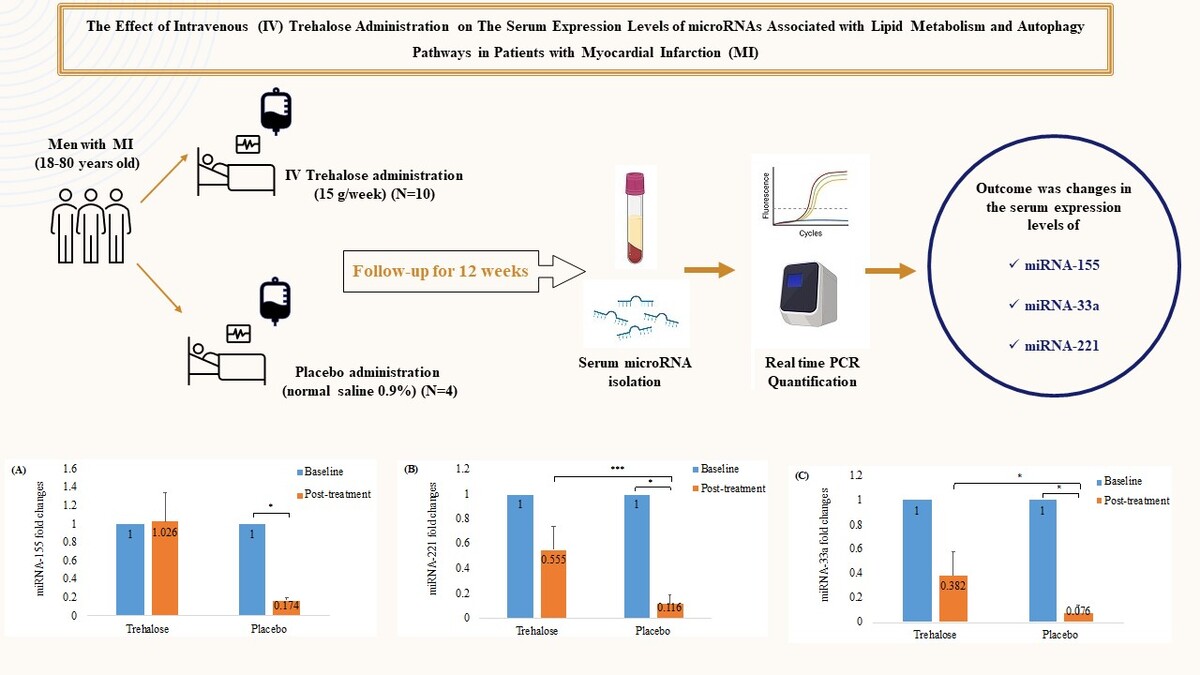Current issue
Archive
Manuscripts accepted
About the Journal
Editorial office
Editorial board
Section Editors
Abstracting and indexing
Subscription
Contact
Ethical standards and procedures
Most read articles
Instructions for authors
Article Processing Charge (APC)
Regulations of paying article processing charge (APC)
CARDIOVASCULAR PREVENTION / CLINICAL RESEARCH
The effect of trehalose administration on the serum expression levels of microRNAs associated with lipid metabolism and the autophagy process in patients with myocardial infarction – post-hoc analysis of the IR-TREAT trial
1
Department of Medical Biotechnology and Nanotechnology, Mashhad University of Medical Sciences, Mashhad, Iran
2
The Institute for Mental and Physical Health and Clinical Translation (IMPACT), School of Medicine, Deakin University, Geelong, Australia
3
Biotechnology Research Centre, Pharmaceutical Technology Institute, Mashhad University of Medical Sciences, Mashhad, Iran
4
Department of Internal Medicine, University Hospital Centre Zagreb, Zagreb, Croatia
5
Polish Mother’s Memorial Hospital Research Institute, Lodz, Poland
6
Applied Biomedical Research Centre, Mashhad University of Medical Sciences, Mashhad, Iran
7
Department of Pharmacology and Toxicology, College of Pharmacy, Al-Zahraa University for Women, Karbala, Iraq
8
Department of Pharmacodynamics and Toxicology, School of Pharmacy, Mashhad University of Medical Sciences, Mashhad, Iran
9
Department of Preventive Cardiology and Lipidology, Medical University of Lodz (MUL), Lodz, Poland
10
Cardiovascular Research Centre, University of Zielona Gora, Zielona Gora, Poland
11
Department of Biotechnology, School of Pharmacy, Mashhad University of Medical Sciences, Mashhad, Iran
Submission date: 2023-07-01
Final revision date: 2023-07-27
Acceptance date: 2023-07-29
Online publication date: 2023-07-29
Corresponding author
KEYWORDS
TOPICS
ABSTRACT
Introduction:
This study aimed to evaluate the trehalose (TRE)-induced changes in the serum expression levels of microRNAs (miRNAs) associated with lipid metabolism and the autophagy process in myocardial infarction (MI) patients to assess the potential protective effects of TRE in these patients.
Material and methods:
This post hoc investigation was performed on serum samples obtained from a pilot randomized, double-blind, placebo-controlled clinical trial (IR-TREAT) that recruited 14 men (aged 18–80 years) with MI and systemic inflammation. The patients were randomized in a 2 : 1 ratio to either TRE (15 g/week, intravenous (IV) administration) (n = 10) or placebo groups (equal volume of saline 0.9%) (n = 4) for a period of 12 weeks. To measure the relative serum expression levels of miRNA-155 (macrophage function regulator), miRNA-221 (autophagy regulator), and miRNA33a (regulator of macrophage autophagy and cholesterol efflux pathway), the SYBR Green quantitative polymerase chain reaction (qPCR) method was used.
Results:
miRNA-155 showed significantly higher serum expression levels in the TRE group (2.772 ±0.73; p = 0.009) when compared to the placebo group. Also, significant reductions in miRNA-155 (0.171 ±0.03; p = 0.016), miRNA-221 (0.116 ±0.07; p = 0.013), and miRNA-33a (0.076 ±0.07; p = 0.025) were observed in the placebo group at the end of the study. Nevertheless, the reduction (normalized to the baseline) of the serum expression levels of miRNA-221 (fold change (FC): 0.87 ±0.20 vs. FC: 0.18 ±0.08; p = 0.009) and miRNA-33a (FC: 0.73 ±0.22 vs. FC: 0.13 ±0.08; p = 0.025) were significantly lower in TRE group than in the placebo group.
Conclusions:
Intravenous trehalose administration did not reduce the expression of miRNA-221 and miRNA-33a as much as placebo. Keeping a steady state of the serum expression levels of these miRNAs associated with lipoproteins metabolism and autophagy in the TRE group might have protective effects in patients with MI.
This study aimed to evaluate the trehalose (TRE)-induced changes in the serum expression levels of microRNAs (miRNAs) associated with lipid metabolism and the autophagy process in myocardial infarction (MI) patients to assess the potential protective effects of TRE in these patients.
Material and methods:
This post hoc investigation was performed on serum samples obtained from a pilot randomized, double-blind, placebo-controlled clinical trial (IR-TREAT) that recruited 14 men (aged 18–80 years) with MI and systemic inflammation. The patients were randomized in a 2 : 1 ratio to either TRE (15 g/week, intravenous (IV) administration) (n = 10) or placebo groups (equal volume of saline 0.9%) (n = 4) for a period of 12 weeks. To measure the relative serum expression levels of miRNA-155 (macrophage function regulator), miRNA-221 (autophagy regulator), and miRNA33a (regulator of macrophage autophagy and cholesterol efflux pathway), the SYBR Green quantitative polymerase chain reaction (qPCR) method was used.
Results:
miRNA-155 showed significantly higher serum expression levels in the TRE group (2.772 ±0.73; p = 0.009) when compared to the placebo group. Also, significant reductions in miRNA-155 (0.171 ±0.03; p = 0.016), miRNA-221 (0.116 ±0.07; p = 0.013), and miRNA-33a (0.076 ±0.07; p = 0.025) were observed in the placebo group at the end of the study. Nevertheless, the reduction (normalized to the baseline) of the serum expression levels of miRNA-221 (fold change (FC): 0.87 ±0.20 vs. FC: 0.18 ±0.08; p = 0.009) and miRNA-33a (FC: 0.73 ±0.22 vs. FC: 0.13 ±0.08; p = 0.025) were significantly lower in TRE group than in the placebo group.
Conclusions:
Intravenous trehalose administration did not reduce the expression of miRNA-221 and miRNA-33a as much as placebo. Keeping a steady state of the serum expression levels of these miRNAs associated with lipoproteins metabolism and autophagy in the TRE group might have protective effects in patients with MI.
Share
RELATED ARTICLE
We process personal data collected when visiting the website. The function of obtaining information about users and their behavior is carried out by voluntarily entered information in forms and saving cookies in end devices. Data, including cookies, are used to provide services, improve the user experience and to analyze the traffic in accordance with the Privacy policy. Data are also collected and processed by Google Analytics tool (more).
You can change cookies settings in your browser. Restricted use of cookies in the browser configuration may affect some functionalities of the website.
You can change cookies settings in your browser. Restricted use of cookies in the browser configuration may affect some functionalities of the website.



